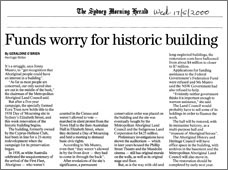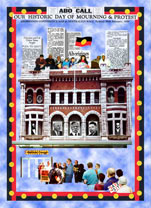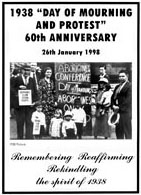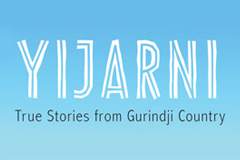
The following week, on 31 January 1938, a deputation of about 20 people met with the Prime Minister, Joseph Lyons, his wife Enid as well as the Minister for the Interior, John McEwen, (whose Department held responsibility for Aborigines in the Northern Territory), to present a proposed national policy for Aboriginals which included 10 points.
Among the deputation were John Patten, William Ferguson, Mrs D. Anderson, Helen Grosvenor, Pearl Gibbs and her mother, and Tom Foster.
They called for Commonwealth control of all Aboriginal matters, with a separate Ministry of Aboriginal Affairs; an administration advised by a Board of six, at least three of whom were to be Aboriginals nominated by the Aborigines Progressive Association; and full citizen status for all Aboriginals and civil equality with white Australians, including equality in education, labour laws, workers compensation, pensions, land ownership and wages.
Lyons replied that, under the Constitution, Commonwealth control was not possible.
From ABO CALL:
Deputation to the Prime Minister
The Australian Abo Call printed a full copy of the statement made to the Prime Minister at the Deputation of the Aborigines on 31st January last. The Prime Minister was accompanied by Dame Enid Lyons and by Mr. McEwan, Minister of the Interior. The Deputation consisted of twenty Aborigines, men and women, and Mr. Lyons gave a hearing of two hours to the statement of our case.
Cooper received a letter from the government in March 1938 notifying him that 'no good purpose would be served by transmitting the petition to His Majesty in the meantime, and action in this regard is therefore being held in abeyance'12.
However, Cooper never gave up on the petition. He continued his campaign of letter writing to Lyons and then Menzies in 1939. Cooper was never to see his vision fulfilled, the petition was never sent to the King. In November 1940 Cooper retired as Honorary Secretary of the AAL and he passed away in 1941.
The Day of Mourning 1938 was a beginning for many future events. The AAL was able to persuade manychurches to declare the Sunday before Australia Day �?Aboriginal Sunday’ with the first of these the 28th January 1940 continuing until 1955, when it moved to the first Sunday in July.
In 1957, with support and cooperation from Federal and State governments, the churches and major Indigenous organisations, a National Aborigines Day Observance Committee (NADOC) was formed, which continues to this day as NAIDOC.
William Cooper’s vision of federalisation of Indigenous affairs and citizenship rights was finally realised in the 1967 Referendum.
26th January 1988 fifty years after the Day of Mourning was a day for Aboriginal people to celebrate their survival.
Australia Day ... Invasion Day ...Survival Day is a photo gallery on flickr of Melbourne celebrations in 2008.
26 January 1998 the National History and Heritage Council organise a 60th Anniversary march to commemorate the 1938 Day of Mourning and the struggle to save the Australia Hall, the site of the first Day of Mourning.




Footnotes
- National Archives of Australia: Representation of Aborigines in Commonwealth Parliament; A431, 1949/1591 p. 83; letter to William Cooper, Honorary Secretary, Australian Aborigines’ League, from Secretary unsigned.




